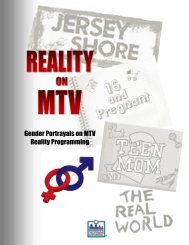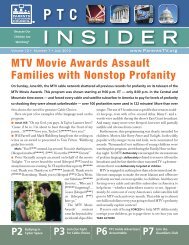Women in Peril - Parents Television Council
Women in Peril - Parents Television Council
Women in Peril - Parents Television Council
Create successful ePaper yourself
Turn your PDF publications into a flip-book with our unique Google optimized e-Paper software.
PARENTS TELEVISION COUNCIL • SPECIAL REPORT • OCTOBER 2009<br />
WOMEN IN PERIL<br />
A Look at TV’s Disturb<strong>in</strong>g New Storyl<strong>in</strong>e Trend<br />
Because Our Children Are Watch<strong>in</strong>g ®
WOMEN IN PERIL<br />
A Look at TV’s Disturb<strong>in</strong>g New Storyl<strong>in</strong>e Trend<br />
October 2009<br />
Overview<br />
Violence and the notion of women <strong>in</strong> peril have played a role <strong>in</strong> enterta<strong>in</strong>ment for centuries. But <strong>in</strong><br />
recent years, storyl<strong>in</strong>es depict<strong>in</strong>g violence aga<strong>in</strong>st females are be<strong>in</strong>g shown more graphically and <strong>in</strong> ways<br />
that have not been seen <strong>in</strong> the history of television. This study is an exam<strong>in</strong>ation of fatal and nonfatal<br />
female victimizations as represented on prime-time broadcast television from 2004 to 2009.<br />
The <strong>Parents</strong> <strong>Television</strong> <strong>Council</strong> observed a significant <strong>in</strong>crease <strong>in</strong> the <strong>in</strong>cidence of female victimization;<br />
an <strong>in</strong>crease <strong>in</strong> the depiction of teen girls as victims; an <strong>in</strong>crease <strong>in</strong> the use of female victimization as a<br />
punch l<strong>in</strong>e <strong>in</strong> comedy series; and an <strong>in</strong>crease <strong>in</strong> the depiction of <strong>in</strong>timate partner violence (i.e., violence<br />
committed by a current or former partner or spouse; a sexual relationship is not necessarily implied).<br />
Background of the Study<br />
The impact of female victimization storyl<strong>in</strong>es has been demonstrated <strong>in</strong> previous scientific studies<br />
show<strong>in</strong>g exposure to filmed violence aga<strong>in</strong>st women leads to decreased perceptions of violence,<br />
systematic reductions <strong>in</strong> emotional reactions, and reduction <strong>in</strong> self-reported physiological arousal to the<br />
violence <strong>in</strong> the films. (D. L<strong>in</strong>z, E. Donnerste<strong>in</strong>, S, Adams, 2006).<br />
Consider<strong>in</strong>g that <strong>in</strong> real life females are generally murdered by people they know, central to any study of<br />
female victimization is the topic of domestic violence. In 64% of female homicide cases reported <strong>in</strong><br />
2007, females were killed by a family member or <strong>in</strong>timate partner (24% of female homicide victims were<br />
killed by a spouse or ex-spouse; 21% were killed by a boyfriend or girlfriend; and 19% by another family<br />
member). (S. Catalano, E. Smith, H. Snyder and M. Ran, September, 2009).<br />
In 2008, the Bureau of Justice Statistics reported females age 12 or older experienced approximately<br />
552,000 nonfatal violent victimizations (rape/sexual assault, robbery, or aggravated or simple assault) by<br />
an <strong>in</strong>timate partner (a current or former spouse, boyfriend or girlfriend). In 2007, 70% of victims killed<br />
by an <strong>in</strong>timate partner were female.<br />
These are stagger<strong>in</strong>g statistics. However, a more recent study (October, 2009) by the Justice<br />
Department’s office of Juvenile Justice and Del<strong>in</strong>quency Prevention reported that most children <strong>in</strong> the<br />
United States are exposed to violence <strong>in</strong> their daily lives. More than 60% of children surveyed were<br />
exposed to violence with<strong>in</strong> the past year, either directly or <strong>in</strong>directly, accord<strong>in</strong>g to data compiled by the<br />
department. The survey found that nearly half of all children surveyed were assaulted at least once <strong>in</strong><br />
the past year, and about 6% were victimized sexually. One <strong>in</strong> five of those between the ages of 14 and<br />
17 reported they had seen a shoot<strong>in</strong>g.
We need to take a closer look at how our culture of violence is be<strong>in</strong>g <strong>in</strong>formed by a violent media<br />
culture, and what patterns of behavior we can expect to emerge <strong>in</strong> the future based on trends we are<br />
currently see<strong>in</strong>g on television.<br />
Study Parameters and Methodology<br />
The purpose of the present study is to compare the qualitative and quantitative differences <strong>in</strong> the<br />
treatments of violence aga<strong>in</strong>st women on prime-time broadcast television between 2004 and 2009.<br />
(Primetime is def<strong>in</strong>ed as the hours 8:00-11:00 p.m. ET/PT Monday-Saturday, 7:00-11:00 p.m. ET/PT<br />
Sundays.)<br />
PTC analysts exam<strong>in</strong>ed all prime-time programm<strong>in</strong>g (exclud<strong>in</strong>g sports and news programs) on the major<br />
broadcast networks (ABC, CBS, Fox, and NBC)* dur<strong>in</strong>g the February and May 2004 and 2009 sweeps<br />
periods for a total of 209.5 hours of programm<strong>in</strong>g. Analysts recorded and categorized the type and<br />
extent of violence <strong>in</strong> each program, as well as the outcome, the gender and apparent age of the victim,<br />
the number of violent scenes with<strong>in</strong> each program, and the number of violent actions with<strong>in</strong> each scene.<br />
*CW and MyNetworkTV did not exist <strong>in</strong> 2004.<br />
Major F<strong>in</strong>d<strong>in</strong>gs<br />
F<strong>in</strong>d<strong>in</strong>g #1: Violence aga<strong>in</strong>st women and teenage girls is <strong>in</strong>creas<strong>in</strong>g on television at rates that far<br />
exceed the overall <strong>in</strong>creases <strong>in</strong> violence on television. Violence, irrespective of gender, on television<br />
<strong>in</strong>creased dur<strong>in</strong>g the study period only 2% from 2004 (N=3840) to 2009 (N=3929), while the <strong>in</strong>cidence of<br />
violence aga<strong>in</strong>st women <strong>in</strong>creased 120% dur<strong>in</strong>g that same period (N=195-429). (For purposes of this<br />
study “<strong>in</strong>cidence” is def<strong>in</strong>ed as the number of storyl<strong>in</strong>es that <strong>in</strong>cluded female victims of violence).<br />
Table 1: Number of Times Female Victims of Violence Were Shown<br />
On Screen dur<strong>in</strong>g Each Study Period for 2004 and 2009<br />
Network<br />
Sweeps<br />
Period 2004 2009<br />
ABC February 9 16<br />
May 17 17<br />
NBC February 12 38<br />
May 15 54<br />
CBS February 57 81<br />
May 39 99<br />
Fox February 13 66<br />
May 33 58<br />
TOTAL 195 429<br />
(The above data does not reflect the number of times the violence was represented [<strong>in</strong>cidence] with<strong>in</strong> each segment. Many<br />
segments conta<strong>in</strong>ed more than once <strong>in</strong>cident).
Table 2: Increase <strong>in</strong> Violence Directed at <strong>Women</strong><br />
Versus General Increase <strong>in</strong> Violence<br />
YEAR FEMALE GENERAL<br />
2004 195 3840<br />
2009 429 3929<br />
% Change 120% 2%<br />
<br />
<br />
Cumulatively, across all study periods and all networks, the most frequent type of<br />
violence was beat<strong>in</strong>g (29%), followed by credible threats of violence (18%), shoot<strong>in</strong>g<br />
(11%), rape (8%), stabb<strong>in</strong>g (6%), and torture (2%). Violence aga<strong>in</strong>st women resulted <strong>in</strong><br />
death 19% of the time.<br />
Violence towards women or the graphic consequences of violence tends<br />
overwhelm<strong>in</strong>gly to be depicted (92%) rather than implied (5%) or described (3%).<br />
EXAMPLES<br />
CROSSING JORDAN - NBC, May 23, 2004<br />
Peter and Jordan do an autopsy on a woman’s decompos<strong>in</strong>g corpse. There is a close-up shot of her<br />
face and then a flashback to the events surround<strong>in</strong>g her death. The capta<strong>in</strong> of a fish<strong>in</strong>g boat rips the<br />
woman’s cloth<strong>in</strong>g and appears to be forc<strong>in</strong>g himself on her. Another fisherman pulls him off. The<br />
capta<strong>in</strong> grabs her and throws her <strong>in</strong>to the wall. She falls aga<strong>in</strong>st the fish hook and blood comes out<br />
of her mouth.<br />
DESPERATE HOUSEWIVES – ABC March 22, 2009<br />
Dave is shown load<strong>in</strong>g a hunt<strong>in</strong>g rifle while camp<strong>in</strong>g <strong>in</strong> the woods with Mike and Kather<strong>in</strong>e and<br />
follow<strong>in</strong>g them while they hike together. He aims the gun at Kather<strong>in</strong>e and shoots her <strong>in</strong> the chest.<br />
This turns out to be Dave’s daydream. Later <strong>in</strong> the episode Dave attempts to enact his plan to kill<br />
Kather<strong>in</strong>e, but fails.<br />
HEROES – NBC, April 27, 2009<br />
Images from Sylar’s past life flash on the screen, <strong>in</strong>clud<strong>in</strong>g a scene of him stabb<strong>in</strong>g a woman <strong>in</strong> the<br />
chest with some scissors.<br />
PRISON BREAK – Fox, May 15, 2009<br />
Sarah is tied up while T-Bag <strong>in</strong>timidates her.<br />
T-BAG: Tell me, has Scoffield ever run up your clock? Has he been man enough to go there? Or is<br />
he sav<strong>in</strong>g it up for the wedd<strong>in</strong>g night?<br />
SARAH: Michael is more man than you could ever hope to be.
T-BAG: How would you know what a man is like? Of the two of us, I bet I've been with more of<br />
them. Look at you, all buttoned up, frigid. Tell me, what does it take to loosen up a girl like you? Is<br />
it music, flowers, touch? Where the f<strong>in</strong>gers do the walk<strong>in</strong>g down to where only…<br />
T-Bag wiggles his f<strong>in</strong>gers down her body.<br />
…<br />
T-BAG: You know I was always th<strong>in</strong>k<strong>in</strong>g the way I was gonna get revenge on Scoffield was to kill him,<br />
driv<strong>in</strong>g a knife right <strong>in</strong>to his bleed<strong>in</strong>g heart. And now, stand<strong>in</strong>g here look<strong>in</strong>g at you I'm th<strong>in</strong>k<strong>in</strong>g<br />
there's someth<strong>in</strong>g worse than death for him.<br />
SARAH: Please, no.<br />
T-BAG: I'll return you <strong>in</strong> one piece, but that piece is gonna be a little used. That's all. And every<br />
time he looks at you, every time he wants to be with you, he's gonna see me.<br />
…<br />
T-BAG: Ooo, I bet you was a tomcat back when you was us<strong>in</strong>g. See nowadays you like to look a fella<br />
<strong>in</strong> the eyes, but back then, back then I bet the last th<strong>in</strong>g you wanted to do was see who you was<br />
keep<strong>in</strong>g company with, huh?<br />
T-Bag spreads her arms apart and handcuffs them to the handles of the slid<strong>in</strong>g glass door.<br />
T-BAG: Now I'm gonna be a gentleman about this and I'm gonna let you choose. You tell me how<br />
you like it Sarah and I'm gonna give ya just what the doctor ordered.<br />
F<strong>in</strong>d<strong>in</strong>g #2: Every network with the exception of ABC demonstrated a dramatic <strong>in</strong>crease <strong>in</strong> the<br />
number of storyl<strong>in</strong>es that <strong>in</strong>cluded violence aga<strong>in</strong>st women between 2004 and 2009.<br />
Table 3: Number of Storyl<strong>in</strong>es that Included Female Victims<br />
of Violence and Percent of Increase by Network<br />
# of Violent<br />
Incidents<br />
2004<br />
# of Violent<br />
Incidents<br />
2009<br />
% of<br />
Increase<br />
Network<br />
CBS 54 118 119%<br />
NBC 24 70 192%<br />
Fox 40 82 105%<br />
ABC 18 25 39%<br />
F<strong>in</strong>d<strong>in</strong>g #3: Although female victims appeared to be primarily of adult age, collectively, there was a<br />
400% <strong>in</strong>crease <strong>in</strong> the depiction of teen girls as victims across all networks from 2004 to 2009.
Table 4: Percent Increase <strong>in</strong> Depiction of Teens as Victims<br />
Network 2004 2009<br />
% of Increase <strong>in</strong> the<br />
Depiction of Teens<br />
As Victims<br />
CBS 2 14 600%<br />
NBC 2 8 300%<br />
Fox 1 8 700%<br />
ABC 1 - -100%<br />
EXAMPLES<br />
C.S.I. – CBS, May 5, 2009<br />
A teenage girl is shown dead <strong>in</strong> a park<strong>in</strong>g lot (more than once). A teenage girl is shown be<strong>in</strong>g<br />
attacked by her friend’s father <strong>in</strong> a flashback. A teenage boy is shown dos<strong>in</strong>g a girl with a date<br />
rape drug <strong>in</strong> her dr<strong>in</strong>k at a party. The same boy is shown attempt<strong>in</strong>g to have sex with the<br />
unconscious girl. Lab techs discuss the presence of GHB and evidence of a sexual assault found<br />
on the teenaged victim.<br />
MEDIUM – NBC, March 9, 2009<br />
Allison is aid<strong>in</strong>g with the <strong>in</strong>vestigation of a murdered girl. She shows a suspect photos of the<br />
victim, whose slit throat is covered <strong>in</strong> blood.<br />
F<strong>in</strong>d<strong>in</strong>g #4: Fox stood out for us<strong>in</strong>g violence aga<strong>in</strong>st women as a punch l<strong>in</strong>e <strong>in</strong> its comedies -- <strong>in</strong><br />
particular Family Guy and American Dad -- trivializ<strong>in</strong>g the gravity of the issue of violence aga<strong>in</strong>st<br />
women.<br />
EXAMPLES<br />
FAMILY GUY – Fox, May 17, 2009<br />
-NARRATOR: And so Griff<strong>in</strong> Peterson and Lady Redbush were happily reunited. Of course,<br />
Griff<strong>in</strong> had to go through the complex, extensive divorce procedure required by 18th Century<br />
Society.<br />
The scene cuts to Peter shoot<strong>in</strong>g Meg dead with a musket.<br />
AMERICAN DAD – Fox, March 29, 2009<br />
-Stan asks a woman from the Gu<strong>in</strong>ness Book of World Records if he could use her hot air balloon<br />
to get back to the U.S. When she refuses, Stan po<strong>in</strong>ts his gun at her face.<br />
Stan: What if I told you I’m about to set the record for shoot<strong>in</strong>g a woman <strong>in</strong> the face the most<br />
times <strong>in</strong> a row?
A man is about to shoot Stan, but Meg kills him first and says, “Nobody shoots my back-up<br />
husband.” Stan says he loves Meg. When Meg approaches for a hug, Stan punches her <strong>in</strong> the<br />
face and takes her shotgun.<br />
F<strong>in</strong>d<strong>in</strong>g #5: From 2004 to 2009 there was an 81% <strong>in</strong>crease <strong>in</strong> the <strong>in</strong>cidence of <strong>in</strong>timate partner violence<br />
on television.<br />
Table 5: Percent of Increase <strong>in</strong> Intimate Partner Violence Across All Networks<br />
Year<br />
Total Number of Intimate Partner Violence Scenes<br />
2004 16<br />
2009 29<br />
TOTAL PERCENT INCREASE FROM 2004 TO 2009 = 81%<br />
EXAMPLES<br />
CSI: MIAMI – CBS, May 10, 2004<br />
Investigators f<strong>in</strong>d a corkscrew that is consistent with the stab wounds on Nicole's body. They<br />
reconstruct what happened <strong>in</strong> a flashback: Nicole and Veronica are fight<strong>in</strong>g. Nicole sw<strong>in</strong>gs a w<strong>in</strong>e<br />
bottle at Veronica and Veronica stabs Nicole. Afterwards, she drags Nicole out of the house, <strong>in</strong>to the<br />
garage, leav<strong>in</strong>g a huge smear of blood on the floor.<br />
As more evidence comes available, <strong>in</strong>vestigators reconstruct the crime. This time, a flashback shows<br />
a man from the health club show<strong>in</strong>g up at Veronica's, upset to f<strong>in</strong>d he was rejected <strong>in</strong> favor of<br />
another woman. He is shown attack<strong>in</strong>g and fight<strong>in</strong>g with Nicole. Nicole hits him with a w<strong>in</strong>e bottle,<br />
and he stabs her with the corkscrew.<br />
THE UNUSUALS - ABC, May 6, 2009<br />
Officer Lewis Powell wakes <strong>in</strong> an alley covered <strong>in</strong> blood, with his off-duty weapon miss<strong>in</strong>g. He tells<br />
Walsh he may have killed someone the night before dur<strong>in</strong>g an alcohol-<strong>in</strong>duced blackout and asks for<br />
his help. They discover that Officer Powell was drugged by a bartender who killed his ex-girlfriend<br />
and tried to frame Officer Powell for the crime. The murder is not shown but the woman’s body is.<br />
She is found <strong>in</strong> a hotel room, face down on a bed with cuts on her body and bruises on her face.<br />
CONCLUSION AND RECOMMENDATIONS<br />
By depict<strong>in</strong>g violence aga<strong>in</strong>st women with <strong>in</strong>creas<strong>in</strong>g frequency, or as a trivial, even humorous matter,<br />
the networks may be contribut<strong>in</strong>g to an atmosphere <strong>in</strong> which young people view aggression and<br />
violence aga<strong>in</strong>st women as normative, even acceptable.<br />
It is our s<strong>in</strong>cere hope that this study will serve as a wake-up call to television producers and network<br />
executives; to members of the advertis<strong>in</strong>g community who make broadcast television programm<strong>in</strong>g<br />
possible; to our elected and appo<strong>in</strong>ted public servants; and most importantly, to the view<strong>in</strong>g public.<br />
While it would be premature to assert that violence toward women is the new norm on television, or
that depictions of violence toward women has reached the same epidemic proportions as all depictions<br />
of violence on TV, this emerg<strong>in</strong>g pattern po<strong>in</strong>ts to a disturb<strong>in</strong>g trend, and it is one to which all parties<br />
concerned must put a stop, before it goes any further.<br />
Countless millions of dollars are <strong>in</strong>vested annually at the local, state, national and <strong>in</strong>ternational levels to<br />
reduce violence aga<strong>in</strong>st women and to lessen its impact on society; but today’s television programm<strong>in</strong>g<br />
may be underm<strong>in</strong><strong>in</strong>g those efforts, as actress Nicole Kidman acknowledged recently. On October 21,<br />
2009, Kidman testified before a House Foreign Affairs subcommittee that is consider<strong>in</strong>g legislation to<br />
address violence aga<strong>in</strong>st women. Dur<strong>in</strong>g question<strong>in</strong>g, Ms. Kidman conceded that Hollywood has<br />
probably contributed to violence aga<strong>in</strong>st women by portray<strong>in</strong>g them as weak sex objects, accord<strong>in</strong>g to<br />
the Associated Press.<br />
Kidman’s observation that Hollywood is part of the problem is consistent with a vast body of academic<br />
and medical research po<strong>in</strong>t<strong>in</strong>g to media violence as a significant risk factor lead<strong>in</strong>g to real world<br />
violence. Childhood exposure to media violence has been found to be predictive of aggressive behavior<br />
<strong>in</strong> both male and female young adults. Identify<strong>in</strong>g with the perpetrators of violence on TV, as well as<br />
the realism of TV violence, also predicts later aggression. (L. Rowell Huesmann, Jessica Moise-Titus,<br />
Cheryl-Lynn Podolski, and Leonard D. Eron, 2003). Therefore, if children see violence toward women<br />
modeled on television, if they identify with the persons committ<strong>in</strong>g the violent acts, and they perceive<br />
what they are see<strong>in</strong>g as be<strong>in</strong>g realistic, research supports the conclusion that this will <strong>in</strong>fluence the<br />
child’s behavior.<br />
Some may argue that the television content cited <strong>in</strong> this report only reflects the realities of the world<br />
today. And it would be naïve to suggest that violence aga<strong>in</strong>st women is less a problem <strong>in</strong> the real world<br />
than it truly is. But given the uniquely pervasive nature of the broadcast medium, and given the public<br />
<strong>in</strong>terest obligations of the broadcast stations, the paramount focus must be placed on the impact that<br />
television programm<strong>in</strong>g is hav<strong>in</strong>g on our society, not vice versa.<br />
Those <strong>in</strong>volved <strong>in</strong> the creation of television programm<strong>in</strong>g must be vigilant not to trivialize, sexualize, or<br />
glamorize violence aga<strong>in</strong>st women. We applaud Ms. Kidman for courageously tak<strong>in</strong>g a stand with her<br />
own career <strong>in</strong> refus<strong>in</strong>g to be a part of those storyl<strong>in</strong>es, and we call on her peers <strong>in</strong> the enterta<strong>in</strong>ment<br />
<strong>in</strong>dustry to reject such messages com<strong>in</strong>g from Hollywood and to work to actively combat the<br />
normalization of violence aga<strong>in</strong>st women.<br />
In 2007 after the release of Dy<strong>in</strong>g to Enterta<strong>in</strong>, the PTC’s last comprehensive analysis of violence on<br />
television, the Federal Communications Commission (FCC) issued a report urg<strong>in</strong>g Congress to take action<br />
to address violent programm<strong>in</strong>g. Congress held one hear<strong>in</strong>g after that report was issued, but the<br />
<strong>in</strong>tense lobby<strong>in</strong>g efforts of the broadcast and cable television <strong>in</strong>dustry led to a swift cessation of any<br />
further debate, and noth<strong>in</strong>g has been done s<strong>in</strong>ce.<br />
Further hear<strong>in</strong>gs on the issue of media violence are long overdue. Legislation may or may not be the<br />
answer, but what is abundantly clear is that the <strong>in</strong>dustry is currently headed <strong>in</strong> a direction with<br />
devastat<strong>in</strong>g consequences to the public. We hope that <strong>in</strong>dustry leaders will commit themselves to a<br />
swift reversal of this trend. The PTC pledges to work tirelessly to hold advertisers that sponsor such<br />
graphic images accountable for underwrit<strong>in</strong>g it. And if the television <strong>in</strong>dustry is unwill<strong>in</strong>g or unable to<br />
take serious steps to reduce or tone down such graphic images, then we will urge the Congress and the<br />
FCC, by virtue of their regulatory authority over the public airwaves, to step <strong>in</strong> and take action.
BIBLIOGRAPHY<br />
D. L<strong>in</strong>z, E. Donnerste<strong>in</strong>, S, Adams, (2006) Physiological Desensitization and Judgments about Female<br />
Victims of Violence. Human Communication Research Volume 15 Issue 4, Pages 509 – 522.<br />
S. Catalano, E. Smith, H. Snyder and M. Rand (September, 2009) Female Victims of Violence Bureau of<br />
Justice Statistics: Selected F<strong>in</strong>d<strong>in</strong>gs.<br />
L. Rowell Huesmann, Jessica Moise-Titus, Cheryl-Lynn Podolski, and Leonard D. Eron. (2003).<br />
Longitud<strong>in</strong>al Relations Between Children’s Exposure to TV Violence and Their Aggressive and Violent<br />
Behavior <strong>in</strong> Young Adulthood: 1977–1992. Developmental Psychology , 201-221.<br />
This study, and other PTC research, is supported by generous grants from:<br />
Big Y Foods, Inc.<br />
The Brown Foundation, Inc., of Houston<br />
Michele and Donald D’Amour<br />
The William E. Simon Foundation<br />
The Stuart Family Foundation
















